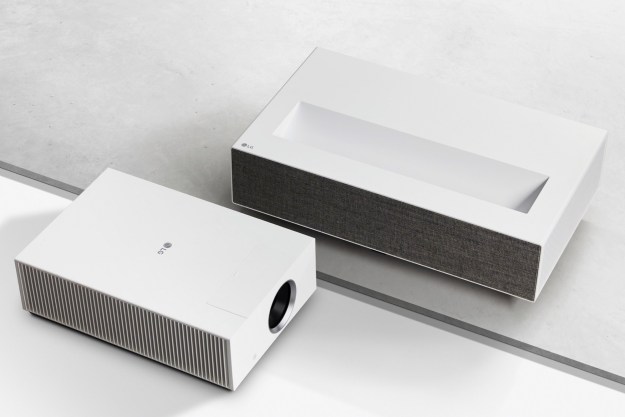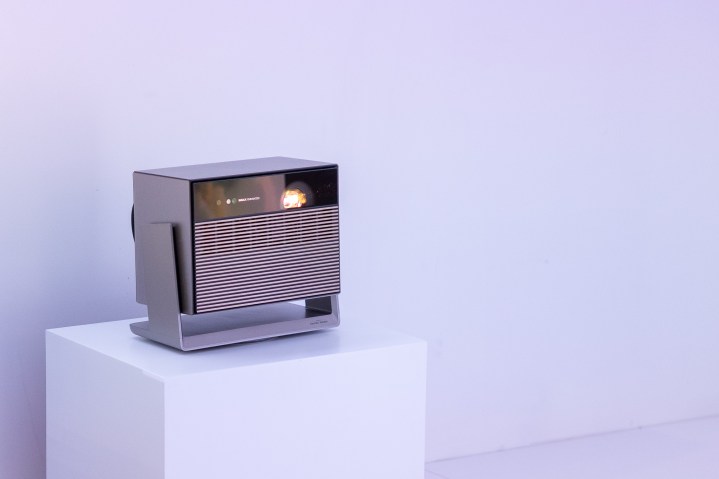
Chinese projector maker Xgimi makes some pretty great portable and premium projectors and somehow does it without charging a fortune for them. At CES 2024, the company showed off two new upcoming projectors: the IMAX Enhanced certified Horizon Max, the company’s brightest projector to date that features a neat precision gimbal system for auto keystoning and some smart screen adaptation tech, and the unique Aladdin, a 3-in-one smart home ceiling lamp, speaker, and projector. I checked it all out at the company’s busy CES 2024 booth.
Xgimi Horizon Max
Building off of the success of last year’s Horizon Ultra 4K projector that boasted support for Dolby Vision, Xgimi (pronounced “ex-jeemee”) hopes to strike gold again with the Horizon Max. Xgimi says the Horizon Max is the “World’s first long-throw projector to feature the IMAX Enhanced certification.”
So, what does that mean, exactly? Well, it can be applied to streaming services (Disney+, for example, has several of its movies viewable in IMAX Enhanced formats, and the Horizon Max can play them), and devices such as TVs, AV receivers, speakers, and, in this case, projectors. In a partnership between IMAX and multi-channel audio company DTS, the IMAX Enhanced team gets together with some technical folks from Hollywood to determine if the devices live up to its standards for resolution, color, contrast, and brightness, as well as DTS:X’s immersive sound. The Horizon Max does.
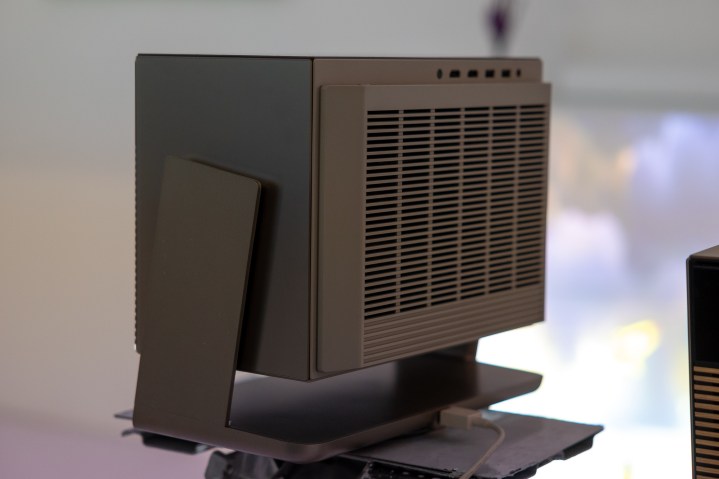
When I reviewed the Horizon Ultra projector last year, I was impressed with its quick and easy auto keystone and alignment features and configurable picture settings, and the Max takes this to a whole new level.
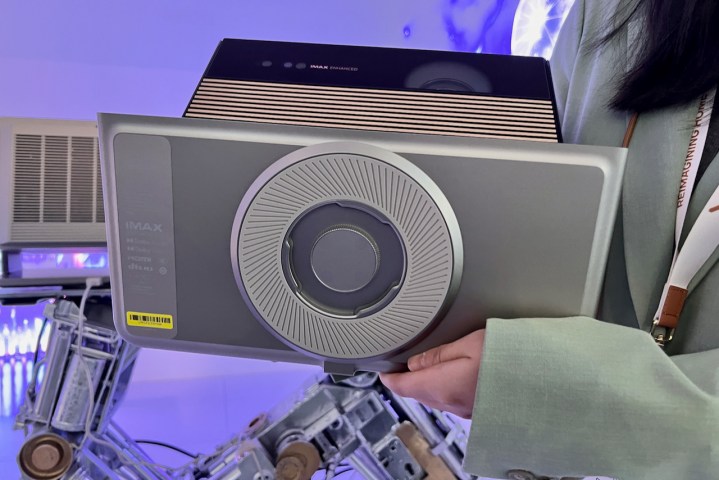
With something Xgimi calls ISA 5.0 (intelligent screen adaptation), Horizon Max uses a motorized gimbal system driven by automated software. Using 3D ToF (time of flight) detection, the projector scans the space, adjusts to the room and the wall or screen you’re using, and configures the settings accordingly.
The CES demo was impressive. In a three-walled demo room with obstacles on the walls (such as a framed picture), the bottom gimbal turned the projector horizontally while the side stand-attached gimbal moved the projector vertically as the image floated its way across the wall. Upon hitting the framed picture (where the 3D ToF comes in), the image just continued to the next wall where it settled on a clear, optimal viewing space — all the while automatically adjusting keystone as it moved, nearly instantaneously.
But beyond that, the projector will also adjust its settings, optimizing them for specific activities and surfaces and remembering them. This could come in handy if you, say, watched all your movies and shows in one room or screen but wanted to move the projector to another room or screen for gaming.
But how does it look? While we’ll have to wait until later this year to get our hands on the 4K projector for a proper review, after a look at the Horizon Max at the company’s booth at CES 2024, I can report that the 180-inch image I witnessed in its demo room on the show floor was beautifully bright and color accurate (if I know my Marvel movies, and I do), with rich blacks and contrast.

Xgimi has achieved this with some new exclusive light technology it has developed, namely Dual Light 2.0. This is the second iteration of the tech that we saw in the Horizon Ultra, but this time, it combines triple MCL lasers typically found in commercial theater projectors that handle color reproduction and contrast, while a phosphor light source is meant to deal with any imperfections caused by the lasers, Xgimi says. The result is a 35% increase in brightness from the Horizon Ultra (3,100 ISO lumens), a contrast ratio of 2000:1, and a wide color gamut (although Xgimi hasn’t released specs on that yet).
Design-wise, the Max takes a few notes from the Ultra (it’s also slightly bigger and taller), with a slick bamboo-blind-like face that, like the Ultra, smoothly slides in and out of place to protect and expose the lamp. It’s also propped up a bit on a new gimbal swivel stand, making it easier to point and adjust your image, which you can do with the remote (ceiling mounters rejoice!).

The Xgimi Horizon Max is slated for a late 2024 release, and Xgimi says that we will see its new Dual Light 2.0 and ISA 5.0 tech make its way into its entire range of projectors this year. No pricing information or additional details have been announced for the Horizon Max yet, but it said it would cost under $3,000, and Xgimi told me that it’s yet to be determined if it will run Android TV or Google TV.
“With the Horizon Max, we’re reshaping home entertainment, delivering a cinematic experience previously reserved for high-end projectors,” Apollo Zhong, CEO and founder of XGIMI, said in a press release. “Horizon Ultra achieved Dolby Vision, and now, Horizon Max boasts IMAX Enhanced certification for picture/image performance.”
It’s a lamp, it’s a projector, it’s Aladdin
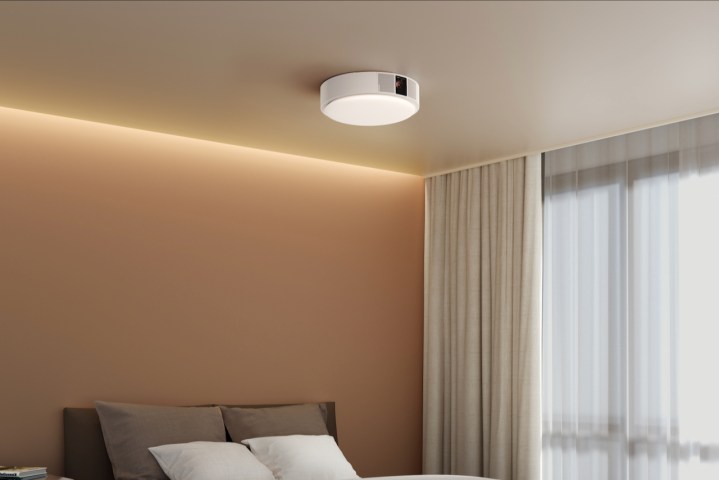
And now for something a little different. CES, if anything, is a great place for companies to show off their more unique new gear, and the Xgimi Aladdin certainly fits in that category.
The company calls Aladdin “a revolutionary product that seamlessly blends a smart ceiling lamp, high-end projector, and connected speakers to optimize your living space.” We’ll see about the revolutionary part, but the rest is true.
Based on the Popin Aladdin 2 Plus design that Xgimi acquired when it bought Popin’s home theater business in 2022, Xgimi’s Aladdin is still in development, with a Japan release in the works for this summer.
From the demo I got at CES, Aladdin does indeed solve many of the issues projector owners can run into, such as placement challenges, screen blockages from people having to walk in front of the light source while watching a movie, and often awkward and unsightly ceiling mounts with cables everywhere (more on that in a bit).
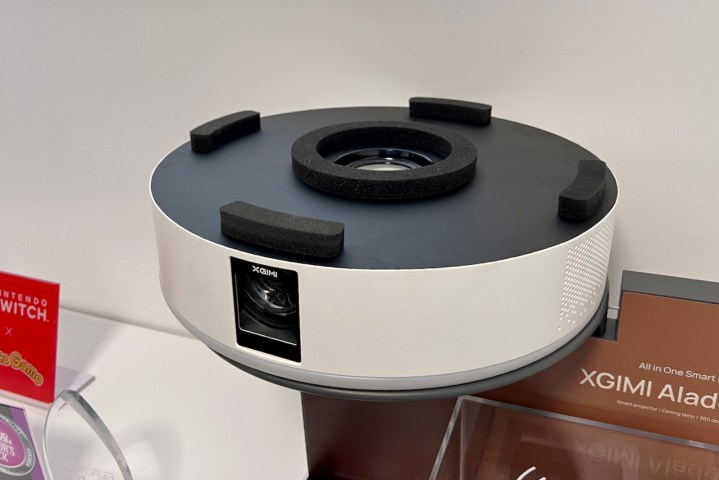
Few projector specs were announced with the Aladdin ahead of CES, other than it being an “HD” projector with a projection ratio of 0.7:1, which means you can mount it approximately 6 feet from the screen for a 100-inch image. The Popin Aladdin 2 Plus featured 900 ANSI lumens of brightness, so we’ll see if Xgimi’s version matches that. In-line with other Xgimi projectors, the Aladdin features Harman Kardon 360-degree sound that can double as a smart speaker for the room when not being used to binge episodes of something on Netflix. It’s also Wi-Fi-capable and features Bluetooth.
The image is what you’d expect from an HD projector, but the room was also a bit bright. That, and we didn’t really look at any movie or TV shows for reference, but the kids games and other content we checked out looked consistent with other HD projectors I’ve seen. The sound from the Harman Kardon speaker was louder and fuller than what I heard in the Horizon Ultra, which I didn’t love, so that’s a good thing.
As far as the Aladdin being a smart ceiling lamp, Xgimi said that when it comes to North America, it will likely be installed like a ceiling fan. The built-in speakers also negate the need for running any in-ceiling wires for sound. Pretty clever.
The Aladdin’s light was beautifully bright, and its temperature can be adjusted with the remote or an app.
And one more thing…
Regarding what else Xgimi has in store for 2024, the Chinese company announced that it will be using new chips from Taiwan’s MediaTek in all of its premium projectors. Additionally, Xgimi has partnered with Google TV and plans to launch a range of new products throughout the year that we can assume will be backed by the Google smart TV operating system, which would be a switch from their current allegiance to Android TV.
Note: This post was updated to correct an error that stated that IMAX and DTS are owned by parent company Xperi.
Editors' Recommendations
- Sony debuts the Bravia 9, its brightest 4K TV ever, alongside new 2024 models
- TCL’s giant 115-inch QM89 is the world’s largest 4K mini-LED TV
- Projectors vs. TVs: Which is best for your home theater?
- LG’s latest 4K UST projector only needs 2.2 inches of wall clearance
- Sony brings laser power, native 4K to every 2022 projector



